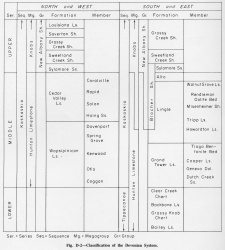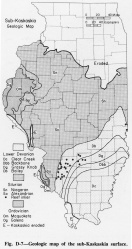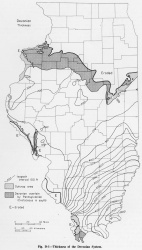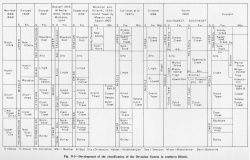Devonian System
Chronostratigraphy: Paleozoic Erathem >>Devonian System
Primary source
Willman, H. B., Elwood Atherton, T. C. Buschbach, Charles Collinson, John C. Frye, M. E. Hopkins, Jerry A. Lineback, and Jack A. Simon, 1975, Handbook of Illinois Stratigraphy: Illinois State Geological Survey Bulletin 95, 261 p.
Contributing author(s)
Charles Collinson and Elwood Atherton
Name
Original description
The Devonian System (Sedgwick and Murchison, 1839).
Derivation
Named for Devonshire, England.
Other names
History/background
Type section
Type location
Type author(s)
Type status
Reference section
Reference location
Reference author(s)
Reference status
Stratigraphic relationships
The Devonian System may originally have covered all of Illinois, but if so it was eroded from the northern part of the state, largely before Pennsylvanian time (fig. D- 1). The upper and lower boundaries of the system in Illinois have been controversial, but in recent years they have become more precise, mainly because of zonation of the conodonts (Collinson, 1961 , 1967; Collinson et al., 1971). The lower boundary is now placed in the lower part of the Bailey Formation rather than at its base (fig. D-2). The upper boundary is placed as high as the lower few feet of the otherwise Mississippian Hannibal Formation or, where those beds are missing, on the top of the Louisiana Limestone or the Saverton Shale. In many earlier reports, the upper boundary was placed as low as the top of the Cedar Valley Limestone or the Lingle Limestone, thus putting nearly all the New Albany Shale Group into the Mississippian System.
In the Illinois Basin, sedimentation was continuous from Silurian into Devonian time and from Devonian into Mississippian time. The major unconformity in the Devonian System is at the base of the Middle Devonian, where an extensive unconformity resulted from regional uplift, withdrawal of the seas, and minor warping. As a result, the Middle Devonian Series successively overlies Lower Devonian, Silurian, and Ordovician strata (fig. D-7) along what is termed the sub-Kaskaskia unconformity-- the base of the Kaskaskia Sequence.
Extent and thickness
The Devonian is less than 100 feet thick in a large part of central and western Illinois, but it thickens into the deep part of the Illinois Basin to more than 1800 feet thick (fig. D-1). It is exposed only in limited areas along and near the Mississippi and Ohio Valleys, principally where the valleys truncate anticlinal areas (fig. D-3).
|
Lithology
The Devonian System is subdivided into three series, Lower, Middle, and Upper. It is the only system in Illinois for which these terms have not been replaced by geographic names. Major stages in the development of the classification are shown in figures D-4 and D-5. The development of separate classifications of the northern and southern parts of the state results from the rise of the Sangamon Arch (fig. D-10) across north-central Illinois during or at least by the end of, Lower Devonian time. Because the Sangamon Arch, rather than the Mississippi River Arch (fig. 12), formed a barrier in the Middle Devonian seas, the formations deposited in central and southern Illinois differ from those in northwestern Illinois. During late Devonian time, the Sangamon Arch subsided, and the seas spread entirely across the area.
The Lower Devonian rocks are dominantly siliceous limestone, dolomite, and chert; the Middle Devonian strata are largely pure limestone and dolomite; and the Upper Devonian sediments are dominantly black, gray, and green shale, although smaller amounts of limestone and siltstone are present. The Lower and Middle Series, with the underlying Silurian carbonates, compose the Hunton Limestone Megagroup, whereas the overlying clastic rocks form the basal part of the Knobs Megagroup (fig. D-2).
The large amount of silica in the Lower Devonian formations appears to have originated partly as finely divided quartz silt that was physically transported to the seas, and partly as a product of intensive weathering of the bordering upland areas, of transportation to the seas in solution, and of deposition as primary or diagenetic chert.
Most Middle Devonian rocks in Illinois are normal marine limestone, but north of the Sangamon Arch the normal sediments are interbedded with evaporites. By late Middle Devonian time, argillaceous sediments rich in spores and in finely disseminated organic debris were being deposited in the relatively deep seas in the southern part of the Illinois Basin, forming black, laminated, fissile shale. The conditions favoring this type of sedimentation were widespread during late Devonian time and black sediments covered the entire basin, although at times the supply of organic material was reduced and gray and green shales were deposited. On the flanks of the positive areas, calcareous sediments accumulated and, in places, are interbedded with black shale.
Middle Devonian rocks, particularly on and near the flanks of the basin, contain beds, lenses, and "floating grains" of quartz sand (Summerson and Swann, 1970). Most of the sand is well rounded and was derived by erosion from earlier Paleozoic formations (such as the St. Peter Sandstone) that were exposed on the Ozark Uplift and the Wisconsin Arch. These sands are thin and discontinuous but they are present throughout the basin. A thin bed of bentonite, the Tioga Bentonite, that originated from volcanoes in the eastern United States is widely traceable in late Middle Devonian rocks.
Core(s)
Photograph(s)
Contacts
Well log characteristics
Fossils
Fossils are common in only a few local beds of the siliceous Lower Devonian rocks, but they are common to abundant in the normal marine Middle Devonian limestones. Brachiopods and corals are the most common and best preserved of the macrofossils (figs. D-6, D-3E). Virtually no fossils are found in the widespread hypersaline limestones. In the Upper Devonian Series, macrofossils are abundant in the limestones but sparse in the shales. However, Tasmanites are abundant and conodonts are common to abundant in the series. The ranges of many Devonian fossils are given by Collinson et al. (1967a).
Age and correlation
The regional correlations of the Devonian formations of Illinois have been discussed by Weller (1944b), Cooper (1944), and Collinson et al. (1967a, b).
Environments of deposition
Economic importance
Remarks
References
COLLINSON, CHARLES, 1961, Kinderhookian Series in the Mississippi Valley, in Northeastern Missouri and west-central Illinois: Kansas Geological Society Guidebook, 26th Annual Field Conference, Missouri Geological Survey Report of Investigations 27, p. 100-109; Illinois State Geological Survey Reprint 1961-U.
COLLINSON, CHARLES, 1967, Devonian of the north-central region, United States, in International symposium on the Devonian System: Alberta Society of Petroleum Geologists, v. 1 , p. 933-939; Illinois State Geological Survey Reprint 1968-G.
COLLINSON, CHARLES, L. E. BECKER, G. W. JAMES, J. W. KOENIG, and D. H. SWANN, 1967a, Illinois Basin, in International symposium on the Devonian System: Alberta Society of Petroleum Geologists, v. 1, p. 940-962; Illinois State Geological Survey Reprint 1968-G.
COLLINSON, CHARLES, M. P. CARLSON, F. H. DORHEIM, and J. W. KOENIG, 1967b, Central Iowa Basin, in International symposium on the Devonian System: Alberta Society of Petroleum Geologists, v. 1, p. 963-971; Illinois State Geological Survey Reprint 1968-G.
COLLINSON, CHARLES, C. B. REXROAD, and T. L. THOMPSON, 1971, Conodont zonation of the North American Mississippian: Geological Society of America Memoir 127, p. 353-395; Illinois State Geological Survey Reprint 1972-A.
COOPER, G. A., 1944, Remarks on correlation of Devonian formations in Illinois and adjacent states: Illinois State Geological Survey Bulletin 68, p. 217-222.
SEDGWICK, A., and R. I. MURCHISON, 1839, Geological Society of London Proceedings, v. 3, no. 63, p. 121-123.
SUMMERSON, C. H., and D. H. SWANN, 1970, Patterns of Devonian sand on the North American craton and their interpretation: Geological Society of America Bulletin, v. 81, p. 469-490; Illinois State Geological Survey Reprint 1970-D.
WELLER, J. M., 1944b, Devonian correlations in Illinois and surrounding states- a summary: Illinois State Geological Survey Bulletin 68, p. 205-213.
ISGS Codes
| Stratigraphic Code | Geo Unit Designation |
|---|---|












